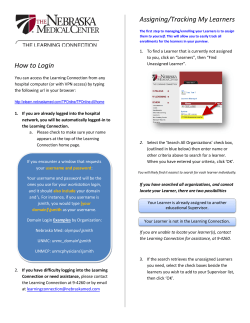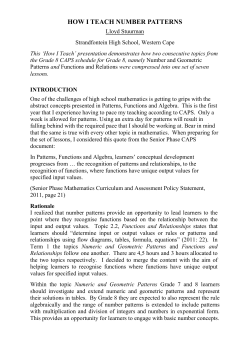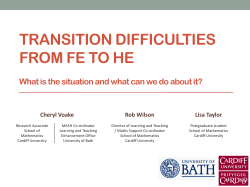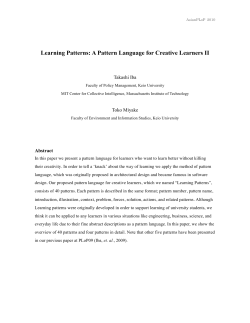
Document 279164
When masks speak: Creative teaching ideas in the PEAP classroom. Maria Papadaki English Language Teacher, MSc in Educational Psychology and Research Methodology th 7 Primary School of Palaio Faliro, Athens, Greece Email address: maria.agglika@gmail.com Introduction Aim As a philosophy in reformed school curricula design of the Pedagogical Institute of Greece, differentiated instruction can address diversity in contemporary classrooms and focus on individual learners’ needs. In an attempt to explain individual differences in second language learning, Ellis (2003) refers to language aptitude, motivation, learner’s beliefs about how to learn the target language, affective states, anxiety in particular, age, learning styles and personality. In primary grades, instructional strategies which facilitate differentiated learning are vital, simply because students at this age vary greatly (Tomlinson, C. A., 2000). The role of the English teacher, within this context, is to select, create and develop instructional material and to integrate motivational teaching methods, embracing, in this manner, a learner-centered perspective to maximize high standards of learning and achievement for all students. The aim of this presentation is to point out the educational utility of making and using masks throughout PEAP activities for A and B grades in Primary Education. Pedagogical Institute teaching guidelines refer to the development of Arts and Drama activities in the teaching of English. PEAP suggested material has been designed according to the needs of a reformed curriculum and hence incorporates a wide range of artistic and theatrical elements. The educational exploitation of making and using masks as components which can contribute towards early foreign language learning, can be a feasible and efficacious tool in the hands of the English teacher. Young learners tend to have short attention spans and a lot of energy, a combination which makes them more interested in the physical and the tangible (Shin, J. K., 2011). Mask-making, as a suggested artistic modality, offers valuable visual and tactile experiences for them. The strong liking that young students have for artistic activity derives from the satisfaction they get from participating in it. Creating masks to be used for an English activity provides a strong motive for participation. Using the masks can become an important interactive tool for the communication of young learners’ thoughts in simple English language. Artistic modalities can have a significant effect on vocabulary learning in the teaching of English (Gorjian, B., Hayati, A., & Barazandeh, E., 2012). In the same sense, mask making invites young learners in the learning process by introducing them to the context of the lesson and the relevant vocabulary elements. Using drama can have clear advantages for language learning and can serve as a pathway to the teaching of oral skills. It fosters motivation by promoting an atmosphere full of entertainment and by enriching the new language experience (Khatib, M., & Sabah, S., 2012). Drama activities encourage children to speak and give them the opportunity to communicate, even with limited language or in a nonverbal context of body movements and gestures (Bas, G., 2008). They may cause embarrassment, though. As a theatrical conventionality, the use of mask in the English lesson is a useful instrument for responsible inclusion of all different individuals in a recreational activity which will reinforce imagination and cooperation and boost simple language usage. Using masks can accommodate shy students overcome their affective barriers to English speaking as they feel safe behind a colourful face (Mayer, D. R., 1999). On that account, masks in the primary English classroom can help young learners feel relaxed and concentrated more on communicating, thus enabling simple words and phrases flow out without worrying. One of the greatest advantages to be gained from using drama activities, with masks in our case, in the English classroom is that it promotes cooperation and collaboration, a sense of social interaction and classroom belonging, which, in turn, leads to increased engagement in the learning process (Barbee, M., 2013). Being a collaborative and participatory teaching approach, it makes large contribution to the development of students’ selfefficacy, especially to those with low levels (Zafeiriadou, N., 2009). Methodological Procedure Data were collected through observation in the primary classroom during the following activities: A party in the jungle (B6), Nelly, the small caterpillar (B10), Let’s play with my toys (D2) from A grade teaching material, and Can a monkey fly..? (B9) from B grade teaching material. Findings were documented according to the mind map that Read (1998) suggests when teachers choose activities for children. Therefore, six aspects of the mask activities were examined: whether they are appropriately supported, meaningful, purposeful, full of practice, social and enjoyable. In order to continue with the dramatization activities of the aforementioned lesson plans suggested by PEAP, the relevant equipment, i.e. the mask templates printed on A4 ordinary paper and the rubber string or straws, was brought in class. Students chose their masks (apart from Nelly, the small caterpillar masks which had been already made for them) and started preparing them (see photos 1 & 2). The teacher helped students open the eye holes (a skill which some of them had already acquired by the end of the school year) and put the rubber string or the straws on them. Photo 1 A party in the jungle Photo 2 Let’s play with my toys In the activities A party in the jungle (B6) and Nelly, the small caterpillar (B10), the students wore their masks to act out the relevant stories, as seen in photos 3 & 4. Photo 3 Leo’s birthday party Photo 4 Nelly’s transformation After the former, the students had a little party in the class to celebrate Leo’s birthday. In the activity Let’s play with my toys (D2) students wore their masks while singing and miming the movements of the dinosaurs (see photos 5 & 6). Photo Photo 5 In the jungle, the mighty jungle ... Photo 6 I’m a mean old dinosaur … In the activity Can a monkey fly..? (B9) students presented themselves as animals and told the class what they could and could not do (see photo 7). Photo 7 I’m an elephant. I can walk but I can’t fly. The lesson A party in the jungle (B6) coincided with our participation in Cambridge English Penfriends, an international activity which helped us connect with schools in Madrid, Spain, and exchange cards with their A grade students. Throughout this programme we had a lot of fun classroom activities, as we took a break from the usual course of studying English. Young learners were helped build their confidence as they communicated in simple English with students from a school in another part of the world, practicing what they had learnt. These communicative activities showed them that English language is practical and helps them communicate internationally with children who do not speak the same language. The masks they had made for the lesson were used as templates to design cards for their penfriends based on the theme ‘Amazing Animals’, as you can see in photo 8. Photo 8 Screenshot of our school profile at Cambridge English Penfriends website Results The descriptive results discussed in this part follow the mind map suggested by Read (1998). According to this map, the mask activities were: 1) Appropriately supported: by low cost visuals and realia that young learners made on their own, by miming, gestures and body movement to get meanings across, and by reflecting on what they had learnt in previous steps. 2) Meaningful: preparing masks made sense to the young students. They could understand that the reason for doing it was to act out a speaking activity. It was built on what they already knew in life and in L1 about wild animals, caterpillars, butterflies and dinosaurs. The mask activities fitted in an understandable context. 3) Purposeful: the activities were challenging, but not too challenging for students at this early age, and helped develop thinking and fine motor skills. English language was used to give instructions on how to make the masks, to act out the stories and to sing the songs. 4) Full of practice: throughout the activities there was a lot of exposure to the target language with constant repetition and recycling of acquired lexical items. All the senses and skills were involved, i.e. auditory, visual and kinesthetic. The activities catered for different learning styles and different personalities. 5) Social: young learners were given the opportunity to choose what mask to wear and, hence, what to say in English, and were encouraged to cooperate and help each other in various steps of the procedure. Dramatizing a story and having a party were classroom activities which were, in fact, shared experiences and events that gave a sense of community among peers and between students and their teacher. 6) Enjoyable: the activities incited student interest and attention and aroused curiosity. Young learners had a sense of fun, and since the activities led to success for all, even those with limited language, the shy and the less confident, they seemed to generate pleasure in English language. Discussion Following a multisensory teaching for early foreign language learning in the first grades of primary school can have a positive effect on establishing and promoting young learners’ language skills and on boosting their motivation to participate (Griva, E., & Semoglou, K., 2012). The use of masks revealed to be workable to very young learners of my school and it served to the growth of language, communicative, collaborative and physical skills. They provided an effective means of drawing and maintaining attention and participation. In young learners’ minds, masks are associated with the carnival. It is very notable that one student said that he really liked they were making masks and it was not carnival time. They all seemed to enjoy the lesson, a fact that will probably maximize their interest in future English lessons. Teaching speaking skills to young learners of English is a demanding and responsible task for teachers. The findings from classroom observation of the consequences and successes of masks suggest that such intervention can have broad educational utility. Involving students in creating the realia related to the lesson, engages them in the learning process. Moon (2005) suggests that when young learners follow instructions to make a mask which they will later use to act out a story, this is a practice which can support their understanding of the target language by listening to it or by using it in the role play, incidentally and not formally and deliberately. In eventual classroom application there was an important improvement of listening and speaking skills. Representation of a story is one of the most frequently used post-narration activities in the early English classroom (Fojkar, M. D., Skela, J., & Kovac, P., 2013). Using drama techniques in the teaching of English to young learners provides motivation and the learning process takes place more like an acquisition, since the affective filter is low (Fuentes, A. G., 2010). Making use of the suggested PEAP drama activities proved to be particularly suitable for young students who were socially distressed and exhibited interpersonal sensitivity, either as a personality trait or because of being at risk of learning difficulties. Taking risks with a foreign language can cause a loss of face, with a hindering effect on the speaker. Behind masks, things were easier for those who had limited English language skills, who were shy and lacked self-confidence. In fact, they felt safe, accepted and loved, and although they were not always relaxed enough to speak, they used animated paralanguage to communicate their message. Wearing a mask they themselves had made was already a success for them. Social classroom dynamics were strengthened since fast learners helped slower peers finish their masks, cooperated to act out the stories and had fun at the party and singing activities. Enriching teaching with enjoyable and child-friendly hands-on learning activities, like making masks, is an essential point to keep in mind when planning a lesson (Malia, E., 2004). Very young learners are unpredictable. They may stand up any time during the lesson for no obvious reason. The enthusiasm and exuberance produced by young learners during drama activities can very easily turn into problems of discipline (Zafeiriadou, N., 2009). Introducing manageable physical activity in the English classroom, so that the students could move around as part of the teaching procedure, involved a lot of purposeful action and occupation. Intentional mobility around the classroom, either to prepare the masks, to act out the story, or, best of all, to sing a song or to have a party, guaranteed entertainment. Activities like the party after Leo’s birthday or the song after Nelly’s transformation into a butterfly were enjoyable experiences which made what was learnt memorable. Dancing and singing behind masks, helped students with no particular music skills to feel safe and placed. When choosing techniques, these have to be of benefit to a school context where there might be limited funding, facilities or equipment (Garton, S. Coplant, F. & Burns, A., 2011). Our drama related activities proved to be low resource tools for teaching English in a middle-class, urban, public school. Our PEAP lesson about wild animals and our participation in the Cambridge English Penfriends programme were unexpectedly interconnected to promote young learners’ perception of English as an international language. Conclusions In summary, masks were found to promote young learners’ attention and create a more entertaining and relaxed climate in the English classroom which fostered inclusion of all students. They are an example of good practice, from a student perspective, since the use of masks involves the learner and not the teacher. This creative teaching technique seemed to strengthen the verbal skills of most young learners. The materials used proved to be of particular benefit for schools with low funding. Conducting an English lesson in the first grades of Primary Education without a coursebook, with clear, accessible guidelines can, in fact, help teachers create practical, tailor-made lessons with simple, brief and feasible educational interventions. Using masks for teaching English facilitates and sustains linguistic, emotional and social development, and, at the same time, fosters and nurtures young learners’ creative and inventive thinking skills. References Barbee, M. (2013). Drama in the Second Language Classroom. Bas, G. (2008). Integrating multiple intelligencies in ESL/EFL classrooms. The Internet TESL Journal, 14, 5. Ellis, R. (2003). The study of second language acquisition. China: Oxford University Press. Fojkar, M. D., Skela, J., & Kovac, P. (2013). A Study of the Use of Narratives in Teaching English as a Foreign Language to Young Learners. English Language Teaching, 6, 6, 21-28. Fuentes, A. G. (2010). Break a leg! The Use of Drama in the Teaching of English to Young Learners. A Case Study. Retrieved on 20/5/2013. Garton, S., Copland, F., & Burns, A. (2011). Investigating Global Practices in Teaching English to Young Learners. London: British Council. Gorjian, B., Hayati, A., & Barazandeh, E. (2012). An evaluation of the effects of art on vocabulary learning through multi-sensory modalities. Procedia Technology, 1, 345-350 Griva, E., & Semoglou, K. (2012). Estimating the Effectiveness and Feasibility of a Game-based Project for Early Foreign Language Learning. English Language Teaching, 5, 9, 33-44. Khatib, M., & Sabah, S. (2012). Task-oriented Conversations: The Implications of Drama for Second Language Acquisition. Theory and Practice in Language Studies, 2, 6, 1120-1127. Malia, E. (2004). Designing Classroom Activities for Teaching English to Children. TEFLIN Journal: A publication on the teaching and learning of English, 15, 1. Mayer, D. R. (1999). Using Masks to Unmask" Shyness" in Speaking a Foreign Language. The Language Teacher, 23, 6, 45-46. Moon, J. (2005). Teaching English to young learners: the challenges and the benefits. Retrieved on 7/6/2013. Read, C. (1998). The challenge of teaching children. English Teaching Professional, 7, 8-10. Shin, J. K. (2011). Teaching English to Young Learners. Retrieved on 20/5/2013. Tomlinson, C. A. (2000). Differentiation of instruction in the elementary grades. ERIC Document Reproduction Service No. ED443572. Zafeiriadou, N. (2009). Drama in language teaching. Issues, 23, 4-9.
© Copyright 2025












